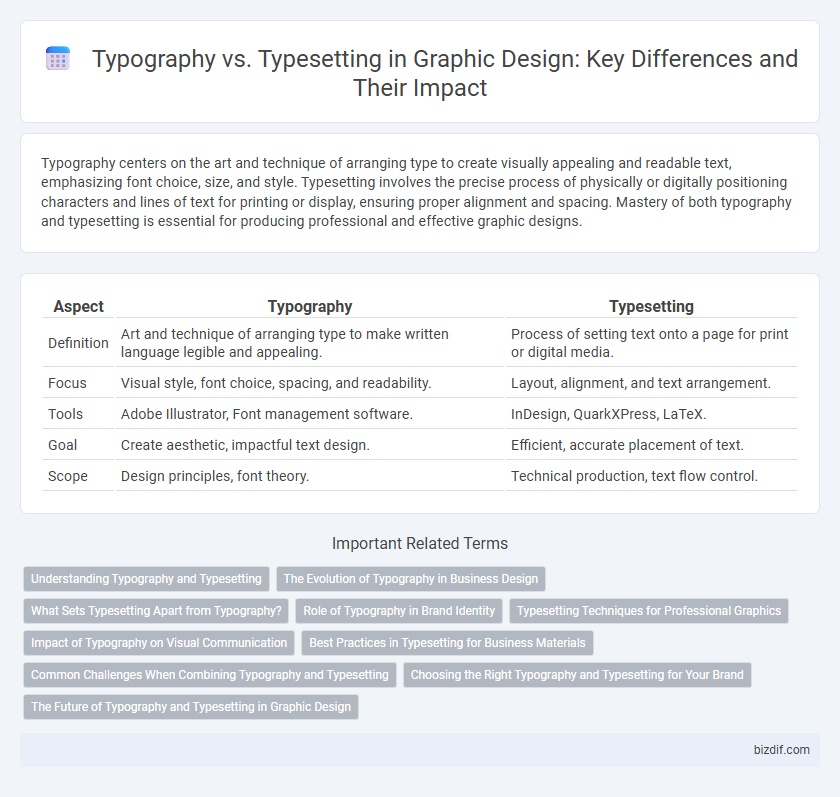Typography centers on the art and technique of arranging type to create visually appealing and readable text, emphasizing font choice, size, and style. Typesetting involves the precise process of physically or digitally positioning characters and lines of text for printing or display, ensuring proper alignment and spacing. Mastery of both typography and typesetting is essential for producing professional and effective graphic designs.
Table of Comparison
| Aspect | Typography | Typesetting |
|---|---|---|
| Definition | Art and technique of arranging type to make written language legible and appealing. | Process of setting text onto a page for print or digital media. |
| Focus | Visual style, font choice, spacing, and readability. | Layout, alignment, and text arrangement. |
| Tools | Adobe Illustrator, Font management software. | InDesign, QuarkXPress, LaTeX. |
| Goal | Create aesthetic, impactful text design. | Efficient, accurate placement of text. |
| Scope | Design principles, font theory. | Technical production, text flow control. |
Understanding Typography and Typesetting
Understanding typography involves selecting and arranging typefaces to convey meaning and aesthetic appeal, focusing on font style, size, weight, and spacing. Typesetting refers to the technical process of organizing text for print or digital media, ensuring readability and visual coherence through proper line length, alignment, and spacing. Mastering both typography and typesetting enhances communication by balancing artistic expression with functional clarity in graphic design.
The Evolution of Typography in Business Design
Typography has evolved from traditional hand-set type to digital fonts, profoundly impacting business design by enhancing brand identity and communication clarity. Advanced typesetting software enables precise control over letter spacing, line height, and alignment, optimizing readability and visual hierarchy in marketing materials. This evolution supports companies in creating consistent, professional designs that strengthen customer engagement and market presence.
What Sets Typesetting Apart from Typography?
Typesetting focuses on the precise arrangement and spacing of text to enhance readability and visual appeal, emphasizing kerning, leading, and alignment. Typography encompasses the broader art and technique of selecting typefaces, font styles, and creating a cohesive design message. The key distinction lies in typesetting's technical execution versus typography's conceptual and aesthetic decision-making.
Role of Typography in Brand Identity
Typography plays a crucial role in brand identity by conveying the brand's personality and values through font choice, style, and hierarchy. Effective typography ensures consistency across all visual materials, enhancing brand recognition and emotional connection with the audience. Unlike typesetting, which focuses on the mechanical arrangement of text, typography emphasizes the art and strategy behind selecting and designing type to reflect the brand's unique voice.
Typesetting Techniques for Professional Graphics
Typesetting techniques in professional graphic design involve precise arrangement of text to enhance readability and visual appeal, utilizing tools like kerning, tracking, and leading to control space between characters, words, and lines. Effective typesetting balances font size, weight, and alignment to create hierarchy and guide viewer attention, while ensuring consistent margins and grids for structured layouts. Mastery of digital software such as Adobe InDesign and QuarkXPress enables designers to implement advanced typesetting features, optimizing text clarity and aesthetic harmony in various media formats.
Impact of Typography on Visual Communication
Typography shapes visual communication by influencing readability, hierarchy, and emotional response through font choice, size, and spacing. Effective typography enhances brand identity and guides the viewer's eye, creating a powerful narrative without relying solely on imagery. In contrast, typesetting focuses on the technical arrangement of text, but the impact on audience perception primarily stems from thoughtful typographic decisions.
Best Practices in Typesetting for Business Materials
Effective typesetting in business materials ensures optimal readability and professionalism by carefully selecting font size, line spacing, and alignment. Emphasizing consistent hierarchy and white space enhances visual clarity and guides the reader through essential information. Prioritizing legible typefaces and avoiding excessive styles minimizes distractions and strengthens brand communication.
Common Challenges When Combining Typography and Typesetting
Combining typography and typesetting often faces challenges such as maintaining readability while ensuring visual harmony across different media formats. Designers must balance font selection, spacing, and alignment to avoid cluttered or inconsistent layouts that can confuse the reader. Effective management of kerning, leading, and hyphenation is essential to create aesthetically pleasing and functional text presentations.
Choosing the Right Typography and Typesetting for Your Brand
Selecting the right typography involves understanding your brand's personality and target audience to convey the desired tone effectively through font style, size, and weight. Typesetting optimizes readability and visual hierarchy by arranging text elements with appropriate spacing, alignment, and layout consistency across various media. Combining thoughtful typography with precise typesetting enhances brand recognition, ensuring your message is clear, engaging, and visually cohesive.
The Future of Typography and Typesetting in Graphic Design
Advancements in variable fonts and AI-driven typesetting tools are revolutionizing the future of typography in graphic design, enabling highly customizable and responsive text layouts. Enhanced automation in typesetting streamlines workflows by precisely controlling spacing, alignment, and readability across diverse digital platforms. Integration of augmented reality and interactive typography further redefines visual communication, making text not only functional but also engaging and immersive.
Typography vs typesetting Infographic

 bizdif.com
bizdif.com